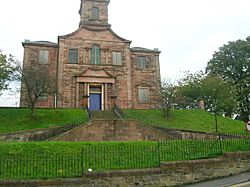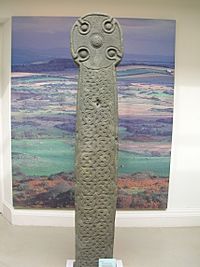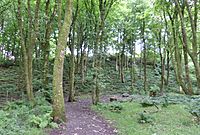Moot hill facts for kids
A moot hill or mons placiti was a special hill or mound used long ago as a meeting place. Think of it like a community hall, but outdoors! In early medieval Britain, people would gather at these "moots" to discuss local issues, make important decisions, read out announcements, and even settle disagreements or court cases. Some moot hills were natural hills, or old burial mounds, but others were built specifically for these meetings.
Contents
What's in a Name?
The word moot comes from an old English word meaning "to meet." Over time, it became a common term across the United Kingdom for any popular gathering.
In England, a folkmoot became a more specific local meeting with legal powers. In Scotland, the term "moot" is used because there isn't one single other word that fits.
In Scottish Gaelic, "Tom a' Mhòid" means "the hill of the court." The word "mòd" is also used for a big cultural gathering, but here it means a place for making judgments. It's related to the English word "moot."
Where Were They and What Were They For?
Many of these meeting hills are still known by names like "moot hill" or "mote hill" today. Others have local names like Court Hill, Judges Hill, or Justice Hill. You might also find names like Knol, Knock, Knowe, or Law, which often refer to hills or mounds.
Sometimes, hills known as "moot hills" were actually mottes, which were mounds built for motte-and-bailey castles. These castles had a wooden or stone tower on top of a mound, surrounded by a ditch. In some cases, a castle mound might have been used later as a moot hill.
Moots might have met on existing old mounds, like ancient burial sites, or on natural hills that were changed a bit for the purpose. One way to tell them apart is size: most moot hills are smaller than castle mottes and don't have signs of defensive walls.
Some moot hills were even surrounded by water, like the one at Mugdock. This would have meant people needed a boat or a raised walkway to get there, possibly to make them harder to reach or for a special meaning.
Cuthills
These were meeting places in early medieval times, mostly in northern Scotland. The name "Cuthill" (or Couthil) comes from a Gaelic word meaning "place of assembly." These were local courts that handled smaller disagreements.
Old Descriptions of Moot Hills
In 1797, a writer named Francis Grose wrote about "mote hills" and "court hills." He said these were places where public justice was handled for large areas, and where local lords held their courts. He explained that in olden times, courts often met outdoors because there weren't buildings big enough for everyone. Judgments were given and carried out in the same spot. He mentioned that near royal palaces, there was usually a moot hill where all the free people of the kingdom would gather to do business and show respect to their king.
Grose also wrote that the last time a local baron (a powerful landowner) made a serious judgment in Nithsdale was around 1697, at Barnside Hill.
How They Started
In Scotland, judges called Brehons used to give out justice from "Court Hills," especially in the highlands. These were called tomemoid in Scottish Gaelic, meaning "Court Hillock." Long ago, there weren't many suitable buildings, so meeting outdoors was the only option. It's believed that Irish settlers brought the idea of using moot hills and their laws with them. Every baron had a moot hill, and even religious groups used them for their courts.
The use of moot hills for law came with the introduction of feudalism by the Normans in England and by Scottish kings like David I in Scotland (1125–1153). These kings gave large areas of land and power to their followers, who then also gave power to their own vassals (people who held land from them).
Local courts were held outdoors, often near a market cross, a standing stone, a moot hill, or a special tree. These courts usually met three times a year.
Baronies
A Barony was an area of land given by the King or Queen to a Baron. These areas became important for local administration and law. The Baron had the power to hold courts for smaller civil and criminal cases. More serious crimes were handled by royal courts.
In Scotland, a Baron was a landowner who held their land directly from the King or Queen, not a noble title like in England. After about 1700, the focus of Baronies shifted more towards local administration and rules for the good of the community. In 1747, the power of Baron Courts to handle criminal cases was greatly reduced. Baronies were largely self-governing, but people could appeal decisions to higher courts.
Baronial Courts
Baronies were like local communities, and their courts helped the area run smoothly. In medieval times, a barony needed a main place where legal matters could be formally handled. This is why many old castle mounds (motes) continued to be used for this purpose.
The baron, or their deputy called the baron baillie, and their council dealt with things like:
- Making sure ditches and hedges were repaired.
- Deciding on damage caused by animals.
- Ensuring the mill (for grinding grain) was working well.
- Even handling cases of neighbors using "unreasonable language."
- They might also set rules for planting crops and fertilizing the land.
The Baron appointed officers for the Baron Court:
- The Baron-Baillie was the main manager.
- The Baron-Clerk was the secretary.
- The Dempster was responsible for carrying out court decisions and announcing the "doom" (the sentence).
- The Baron-Sergeant kept order, called people to court, and made sure civil decisions were followed.
- The Procurator Fiscal was like the prosecutor in court cases.
In 1746, a law called the Heritable Jurisdictions (Scotland) Act 1746 took away the power of life and death from Baron Courts and greatly reduced their criminal powers. This meant most moot hills stopped being used for legal judgments.
The Abolition of Feudal Tenure etc. (Scotland) Act 2000 removed almost all remaining parts of the old feudal system, except for the baronial titles themselves.
Fairness in Justice
An old story from Ayrshire tells how a baron once made a judgment against an innocent man just because a visitor wanted to see it. This was hopefully a rare case, but the system did have problems, like unfairness and judges who weren't trained in law. People could appeal to higher courts. Sometimes, the actions of baron baillies were very harsh. They found many ways to make money, such as:
- The "bailie's darak," which was a day's work from every tenant each year.
- Taking all the belongings of those who faced serious consequences.
- Setting and keeping fines for things like hunting game or cutting wood.
- The "Herial Horse," which was the best animal a tenant owned when they died. This was taken from the family, even when they needed help the most. These practices brought a lot of extra money to the baillie of a large barony.
Calling People to the Moot
Sometimes, people needed to be called to the moot for judgments or meetings. This was sometimes done by ringing a bell placed on or near the moot hill, especially if the meeting date wasn't set in advance. At Greenhills in North Ayrshire, it's said a flag was raised at a special stone. It's also likely that bonfires were lit as signals, with smoke during the day or light at night. Some places still have names like 'Bonfire hill' or 'Bonfire knowe'. The Tarbolton moot hill was used for bonfires until at least the 1800s.
Special Links with the Land
The importance of connecting directly with the land is shown by people standing on their "home" soil at the Scone moot. At the Tynwald Hill on the Isle of Man, soil from every parish was used to build the hill. This practice might be linked to old beliefs and ceremonies, like the footprints carved into rocks at places like Dunadd.
In the 1400s, the Tinwald Mote near Dumfries was still the legal center of the barony. To show ownership of land, a ceremony called "sasine" was performed. This involved giving the new owner a handful of earth and stone from the land in front of witnesses. This shows why many motes, like the one at Ellon, were kept even when little else remained of a baron's possessions. The mote still represented the importance of the earldom.
The sasine was the legal act of registering land ownership. It used to involve the seller giving the buyer a bowl full of earth from the land or a stone from the house. This symbolized the transfer of ownership. Similarly, land rent might be symbolized by a bowl of grass, and a tithe (a payment) by a bowl of grain.
The End of Moot Hills
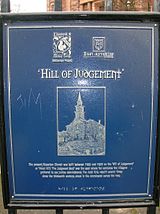
In Scotland, the feudal system, which tied people to their local lords, was linked to the Jacobite risings. Because of this, the government took steps to weaken the system. After 1747, moot hills were no longer used for baronial courts. Also, the need for a gathering place for soldiers became a thing of the past. The building of Moot halls (indoor meeting places) meant there was no longer a need to meet outdoors.
Moot hills gradually lost their importance. Many were even plowed away and forgotten. Only a few are remembered through place names or local stories. Some moot hills found new uses, like Knockenlaw, which became a protective wall for a gunpowder storage building, or Chapel Hill, which was used for watching horse races.
A few, like the Tynwald Hill on the Isle of Man, are still used today. Some were built on and took on new roles, such as the moot hill at Riccarton near Kilmarnock, which had a church built on it in 1823.
Finding Old Moot Hills
Many barony lands were combined over time, so some moot hills stopped being used even before 1747. These hills might still be in the landscape, but often without any local stories about them. Place names can be a clue, especially if local traditions still exist. Old written records can also help. For example, a record from 1346 mentions a "William Baillie, the Baillie of Lambistoun," which helps confirm that modern-day Lambroughton was once a barony. Old gravestones sometimes recorded the jobs of important people, like baron baillies.
Some Moot Hills and Their Stories
Records of these sites are sometimes lost, so connections to baronies are made when there's good evidence from records, place names, or local stories.
Scotland
Aberdeenshire
- Court Hill, Braefoot. A small, cultivated hill. Local stories say it was once where the baronial court met.
- Moot Hill, Ellon. This was the meeting place for ancient Celtic leaders and later Norman Earls. Today, it's marked with a small monument.
Angus
- Courthill, Lunan. A nearby farm keeps the name of this moot hill, where the barons of Red Castle held their courts.
Argyll and Bute
- Court Hills or Gallowhill, Luss. Two natural mounds that were once the Courthill and Gallowshill for the Clan Colquhoun.
Ayrshire (East)
- Bowie's Munt – Kilmaurs, East Ayrshire. A large wooded mound with a ditch around it.
- Chapel Hill, Chapeltoun, Stewarton. A flat-topped hill, possibly a Moot Hill. It was also known as Jockey's cap, used for watching horse races.
- Judge's Hill – Barony of Loudoun. A possible man-made 'Moot Hill' near the old Loudoun Castle.
- Judgement Seat in Riccarton near Kilmarnock. A church, built in 1823, now stands on this old justice mound.
- Knockenlaw, Barony of Roberton, Kilmarnock. This mound was once used for a "court" by the Earl of Glencairn. A powder storage building was later built into the mound.
- Law Mount, Barony of Lambroughton and / or Lainshaw by Stewarton. This artificial mound was likely the Justice Hill where court judgments were announced.
Ayrshire (North)
- Court Hill, Dalry. This was both an ancient burial mound and a moot hill. It once had a wooden castle on top.
- Court Hill, near Hill of Beith in the Barony of Beith. It's a flat-topped mound, mostly artificial, where the Abbot of Kilwinning held courts.
- Green hill, Barony of Giffen, Barrmill. This artificial mound was where the Giffen Castle Baronial Court's judgments were announced.
Ayrshire (South)
- Law Hill – The Fullartons of Fullarton house, Troon, held courts at the Law Hill. It was almost leveled by farming, so a pillar was put there to mark the spot.
- Knockushion, Girvan. This "Hill of Justice" was a Law or Court Hill. A modern pillar now marks the spot, stating that King Robert the Bruce held court here.
- Tarbolton Mote, Hoodshill or Torbol . Parish of Tarbolton. A large mound on the edge of the village, classified as a castle mound, but also the Court Hill of the Barony of Tarbolton. It was used for bonfires annually.
Some Ayrshire moot hills
-
The Chapel Moot Hill from the Annick Water.
-
A close up view of Stacklawhill.
-
Craighead Law, possibly a Justice or Moot Hill.
Dumfries and Galloway
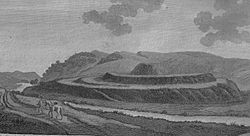
- Barnside Hill was a place for judgments for the area of Lag.
- Court Hill, Tynron. A small hill where the Courts of the barony of Aird were held.
- Motte of Urr. This was a major legal center for the Kings of Galloway.
- Tinwald – A mound that was once a bailey or motte.
East Dunbartonshire
- Mugdock Moot Hill – This hill was once an island in Mugdock Loch. Prisoners from Mugdock Castle's jail were rowed to Moot Island for trial.
Fife
- Moat Hill – Cupar. This hill has been known by many names, including Moot Hill, and was likely where the Justiciar of Fife held courts.
Glasgow
- Doomster Hill – Parish of Govan. A large earthen mound that stood near the river Clyde. It was removed in the early 1800s. The "Doom" was the name for the sentence read by the court's Deemster.
Highland
- Moot Hill, Dingwall. The name "Dingwall" comes from a Norse word meaning "thingvollr," the place of assembly for the Norse "thing" court. That court met on an earthen mound.
Perth and Kinross
- Moot Hill, Struan. This assembly mound is thought to be an early stronghold of the Chiefs of Clan Donnachaidh, and likely a moot.
- Scone Moot Hill. This is the famous site where Scottish Kings were crowned. It's also called 'Boot Hill', possibly from an old tradition where people swore loyalty to their king by wearing earth from their own lands in their boots.
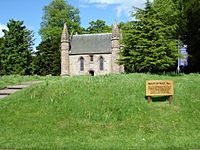
East Renfrewshire
- Castle Hill, Eaglesham. Also known as the 'Deil's Planting'. This is a possible Moot Hill for the Barony of Eaglesham.
Renfrewshire
- Courtshaw Hill – near the old Castle Semple mansion.
England
Buckinghamshire
Cumbria
- Carlisle Moothill. Records show that in 1547, a court was held at the Moothill beside Carlisle.
Wiltshire
- Merlin's Mount. In the grounds of Marlborough College.
- Swanborough Tump, a meeting place for the Swanborough Hundred.
Yorkshire
- Moat Hill Birstall
Isle of Man
- Tynwald, St John's. This stepped structure is very old and is now thought to have originally been a Bronze Age burial mound. It is said to be made of earth brought from each of the seventeen parishes of the Isle of Man.
Images for kids
-
One of the two pit prisons in Hailes Castle, East Lothian


